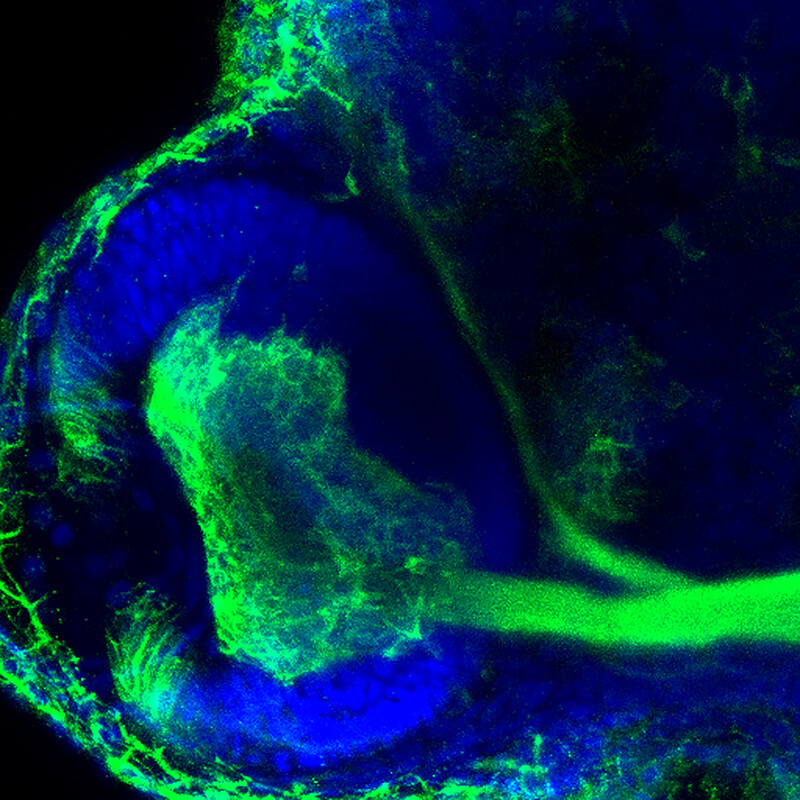July 12, 2018
Chemicals associated with oxidative stress may be essential to development
 The eye of a zebrafish embryo deficient in NADPH oxidase 2 has an enlarged ganglion cell layer (green) and altered innervation of the brain, which leads to problems with signaling between the eyes and the brain.
Download image
The eye of a zebrafish embryo deficient in NADPH oxidase 2 has an enlarged ganglion cell layer (green) and altered innervation of the brain, which leads to problems with signaling between the eyes and the brain.
Download image
WEST LAFAYETTE, Ind. — Some level of molecules linked to oxidative stress may be essential to health and development, according to new animal studies.
Reactive molecules derived from molecular oxygen, known as reactive oxygen species (ROS), increase dramatically in the body during times of environmental stress or disease. This stress can result in significant damage to cells and is associated with negative health consequences such as aging, male infertility, degenerative diseases and cancer.
“We think there’s an ideal intermediate concentration, but neither extreme is good,” said Daniel Suter, a professor of biological sciences at Purdue University.
In a recent study, Suter’s team looked at an enzyme that produces ROS in zebrafish embryos to see if it’s essential to the development of their nervous systems. Inhibiting this enzyme, NADPH oxidase (Nox), resulted in complications with signaling between the eyes and the brain. The findings were published in The Journal of Neuroscience.
The research team used a drug called celastrol to inhibit Nox activity, which led to defects in the formation of the ganglion cell layer and optic nerve, both of which send signals from the retina of the eye to the brain.
But a drug could affect other enzymes besides Nox, so the researchers needed to confirm their results with another approach. The team turned to CRISPR, a system for modifying genes in living cells and organisms, to mutate Nox genes in the zebrafish embryo.
This method also allowed the researchers to differentiate between different isoforms of Nox. Their findings show that Nox2 could be functionally important to neuronal development, whereas mutations in Nox5 could lead to more general developmental problems.
“This is really a study about the role of ROS as signaling molecules in normal development, but it has key applications for human health,” Suter said. “If you take too many antioxidants to treat disorders or injuries, you could go into a range where you get negative effects, because ultimately you need some ROS for normal signaling. We’re trying to figure out if there is a certain range that’s best.”
Researchers from the Suter, Deng, and Leung labs in the Department of Biological Sciences; Purdue’s Institute for Integrative Neuroscience; Institute of Inflammation, Immunology and Infectious Disease; and Bindley Bioscience Center contributed to this work. The research was supported by grants from the National Science Foundation, Purdue Research Foundation, Office of the Executive Vice President for Research and Partnerships, National Institutes of Health, Purdue Center for Cancer Research, and the International Retinal Research Foundation.
Writer: Kayla Zacharias, 765-494-9318, kzachar@purdue.edu
Source: Daniel Suter, 765-496-1562, dsuter@purdue.edu
Note to journalists: For a copy of the paper, please contact Kayla Zacharias, Purdue News Service, kzachar@purdue.edu
ABSTRACT
nox2/cybb Deficiency Affects Zebrafish Retinotectal Connectivity
Cory J. Weaver, Aslihan Terzi, Haley Roeder, Theoore Gurol, Qing Deng, Yuk Fai Leung, Daniel M. Suter
NADPH oxidase (Nox)-derived reactive oxygen species (ROS) have been linked to neuronal polarity, axonal outgrowth, cerebellar development, regeneration of sensory axons, and neuroplasticity. However, the specific roles that individual Nox isoforms play during nervous system development in vivo remain unclear. To address this problem, we investigated the role of Nox activity in the development of retinotectal connections in zebrafish embryos. Zebrafish broadly express four nox genes (nox1, nox2/cybb, nox5, and duox) throughout the CNS during early development. Application of a pan-Nox inhibitor, celastrol, during the time of optic nerve (ON) outgrowth resulted in significant expansion of the ganglion cell layer (GCL), thinning of the ON, and a decrease in retinal axons reaching the optic tectum (OT). With the exception of GCL expansion, these effects were partially ameliorated by the addition of H2O2 , a key ROS involved in Nox signaling. To address isoform-specific Nox functions, we used CRISPR/Cas9 to generate mutations in each zebrafish nox gene. We found that nox2/cybb chimeric mutants displayed ON thinning and decreased OT innervation. Furthermore, nox2/cybb homozygous mutants (nox2/cybb / ) showed significant GCL expansion and mistargeted retinal axons in the OT. Neurite outgrowth from cultured zebrafish retinal ganglion cells was reduced by Nox inhibitors, suggesting a cell-autonomous role for Nox in these neurons. Collectively, our results show that Nox2/Cybb is important for retinotectal development in zebrafish.

